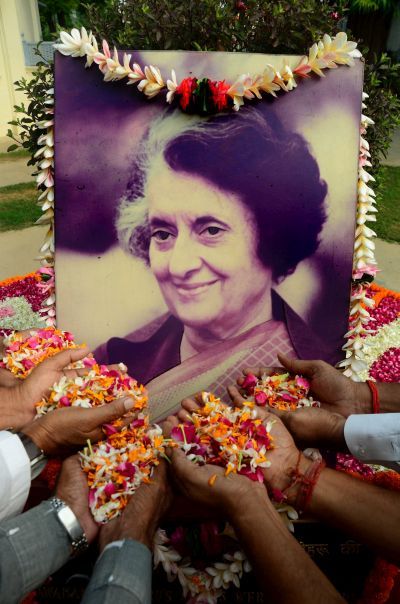 It is unconscionable to choose between Sardar Patel, who united India physically, and Indira Gandhi, who gave meaning, content and pride to the unity of the nation and became a martyr at the altar of national unity, says Ambassador T P Sreenivasan.
It is unconscionable to choose between Sardar Patel, who united India physically, and Indira Gandhi, who gave meaning, content and pride to the unity of the nation and became a martyr at the altar of national unity, says Ambassador T P Sreenivasan.
This year, on October 31, Indians were offered a Hobson’s choice between the Iron Man and the Iron Lady of India for veneration. Every patriotic Indian chose both, since it is unconscionable to choose between Sardar Patel, who united India physically, and Indira Gandhi, who gave meaning, content and pride to the unity of the nation and became a martyr at the altar of national unity.
Needless to say, a weak domestic policy cannot create a strong foreign policy and vice versa. Both should serve the developmental and security goals of the nation. As the prime minister from 1966 to 1977 and again from 1980 to 1984, Indira Gandhi pursued both with determination to become ‘the greatest PM of India’ (India Today’s survey) and ‘the Woman of the Millennium’ (BBC survey).
Richard Nixon may have called her a “witch” and a “clever fox”, but no one called her a “dumb doll” for long after she assumed office. She turned into a Durga in the eyes of an artist, and India itself in the words of her ardent followers.
Indira Gandhi may be remembered in history for her game-changing domestic legislations and actions, but her successes and visionary approach to foreign policy are no less significant.
The liberation of Bangladesh alone should secure a permanent place for her among the makers of the modern world. In one stroke, she eliminated the pincer of Pakistan on two sides of India and also won praise for liberating a people from the clutches of a dominant section of the country.
Mujibur Rahman, who was denied his right to rule the whole of Pakistan, was enabled to be the head of his “Golden Bengal”.
Indira Gandhi had no qualms to sign a Treaty of Friendship with the Soviet Union, which had a provision that any attack on either country will be construed as an attack on the other. Where is nonalignment, asked critics. But she was not concerned about such technicalities. Foreign policy is meant to serve the nation, not to confine itself to definitions.
The concept of nonalignment was broadened to cover the freedom to choose friends and allies. The Treaty kept the American fleet and the Chinese dragon at bay when the Indian army fought side by side with the “Mukti Bahini” till the Pakistan commander, General Niazi, signed the instrument of surrender, ushering in the advent of two nations -- a liberated Bangladesh and an invigorated India. Never before had India been such a dominant power in South Asia.
Indira Gandhi was as gracious in peace as she was fierce in war. She returned the Pakistani soldiers and the territory in the west and signed the Simla Agreement to begin the ending of the Kashmir issue.
When she agreed to turn the ceasefire line into a Line of Control, with adjustments to follow geographical features, she believed that Pakistan would eventually recognise it as the international border.
Whether Zulfikar Ali Bhutto had a secret agreement with her or not, he had explicitly vowed to keep the issue within the bilateral framework. No wonder, Pakistan hanged the Simla Agreement, together with Bhutto.
Indira Gandhi’s position on Afghanistan, that the Soviet troops would help maintain stability in the country, and her recognition of Kampuchea were clearly pro-Soviet in the eyes of the world, but she would not accept the Soviet notion of ‘Collective Security in Asia’, which would have landed her in the Soviet camp. Her management of the cold war was as masterly as the hot war in Bangladesh.
The decision to conduct a “peaceful” nuclear explosion in 1974 did not please the Soviets, but since they and the Americans had turned down her request for a nuclear umbrella in return for signing the Nuclear Non-proliferation Treaty, they could not protest too much or impose sanctions.
It took a gritty Iron Lady to pave the way for the declaration of India as a de facto nuclear weapon state in 1998 by Atal Behari Vajpayee. It was quite amusing that some States, which insisted that India had become a nuclear weapon State in 1974, maintained that India had not become a weapon State on account of the tests in 1998.
Palestine was a matter of faith for India from the beginning and Indira Gandhi stood firm and developed a cordial relationship with Yasser Arafat. But she had the foresight not to isolate Israel altogether. India had recognised Israel and had consular linkages with it.
She had quietly authorised contacts with Israel to benefit from Israel’s strength in agriculture, irrigation and security. She had laid the foundations of a flourishing relationship with Israel, which developed after Prime Minister P V Narasimha Rao established full diplomatic relations with that country.
Indira Gandhi’s uncanny ability to anticipate global developments and to take precautionary positions was best demonstrated when she decided to go to Stockholm to attend an environment conference in 1972. She was the only prime minister other than the host to attend the conference, as against more than a hundred global leaders who went to Rio in 1992.
She presciently sensed that the Stockholm conference was the beginning of an effort to usher in environmental colonialism. She saw how the West, having unscrupulously engaged in conspicuous consumption of the resources of the earth, was planning to deny development to the developing countries by imposing environmental conditionalities.
The questions she asked in Stockholm -- like “are not poverty and need the greatest polluters?” -- reverberated in the debate that developed regarding the linkages between environment and development and gave rise to the demand of the developing countries that “polluters must pay” for the regeneration of nature.
The assertion made by her, that the West had the main responsibility to take remedial measures, led to the compromise in Rio that all of us had “common, but differentiated responsibilities”. The Indian negotiators on climate change in Rio used the formulations of Indira Gandhi with decisive effect.
The signing of the Antarctic Treaty in 1983 to obtain consultative status for India was another significant measure Indira Gandhi took by stepping away from the consensus within the nonaligned movement, which wanted to leave Antarctica as a common heritage of mankind.
She did not want to remain outside an arrangement, which set aside Antarctica as a scientific preserve and established freedom of scientific investigation and banned military activity on that continent. She was not deterred by the fact that the Treaty was an arms control agreement among the states, which had territorial claims.
Apart from facilitating research by India on the icy continent, she ensured that India would be consulted on any future dispensation that may emerge on the continent.
In a single letter, Sardar Patel taught the architect of Indian foreign policy, Pandit Jawaharlal Nehru, a couple of lessons on China. If Pandit Nehru had heeded his advice, India-China relations would have taken a different turn.
Indira Gandhi fearlessly protected and promoted Indian interests by turning her father’s “moral politik” to realpolitik. Her timely moves in the international arena gave India immense strength.
Both Patel and she deserve our gratitude and reverence now and forever.
T P Sreenivasan is a former Ambassador of India and Governor for India at the International Atomic Energy Agency; Executive Vice-Chairman, Kerala State Higher Education Council; and Director General, Kerala International Centre.
You can read Ambassador Sreenivasan's earlier columns here.
Photograph: Floral tributes being offered to former prime minister Indira Gandhi on her death anniversary on October 31, 2014. Photograph: PTI Photo.
Also read:
At last! Lifting the curtain on Sardar Patel's legacy
Photos: Honouring Indira Gandhi, India's Iron Lady









